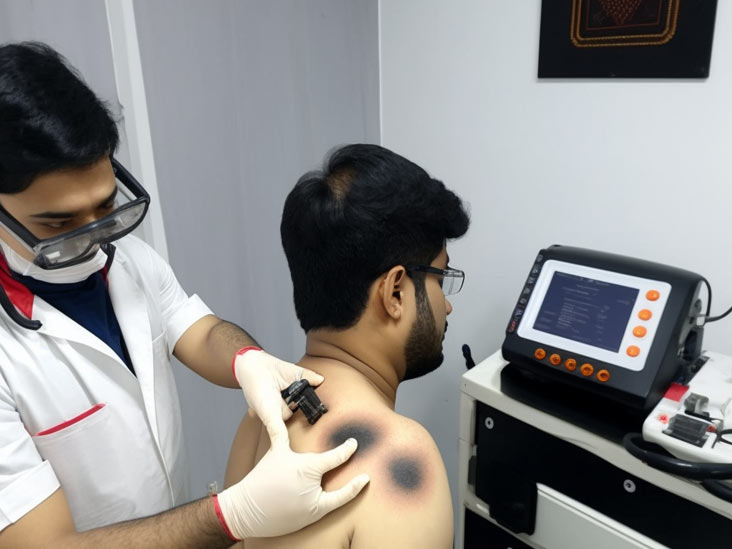
Tattoo removal is the act of erasing a tattoo that you no longer want.
How tattoos are done
Tattoos are made by inserting coloured materials under the skin. When a tattoo is healed, its design becomes visible.
Why do people tattoo
Tattooing has become a fashion statement for some people, but it’s also used to commemorate life events or show devotion to one’s religion. There are many different types of tattoos. For example, you can get a black-and-white tattoo or one that is filled in with colour. Some people choose to have tattoos on their backs, arms or legs.
Tattoos may be cool at 20, but they’re often considered inappropriate for those over 30.
Tattoos are generally permanent, but people have tried many methods to remove or alter their tattoos.
Why remove tattoos?
You may be denied job opportunities because of your tattoos—especially in countries that consider such body art taboo.
Some religious groups bar people with tattoos from entering their temples, churches and mosques. In some cultures, tattoos are seen as symbols of rebellion or criminality and their wearers may be ostracised.
In the past, political party emblems or logos were often tattooed on followers’ bodies. Today, those who change their allegiance may be required to remove or alter tattoos if they wish to remain members in good standing.
Risks with tattoo removal
It is possible to remove a tattoo, though the removal process can be costly and time-consuming.
Historically, the most common methods for removing skin tags have included dermabrasion, Salabrasion (scraping away of tissue), liquid nitrogen cryotherapy (the application of extremely cold temperatures to destroy cells) and surgical removal.
These methods are not without drawbacks and may leave a more difficult-to-treat scar than was present before the tattoo.
The expense and pain involved in removing tattoos have decreased compared to earlier days.
Preparing for tattoo removal
If you’re thinking about getting a tattoo removed, visit our clinic and see our dermatologist.
He or she can discuss the various options with you and help recommend a method that will likely be effective based on your particular tattoo.
For instance, some tattoo inks respond more favourably to laser treatments than others. Also, small tattoos are often easier to remove than larger ones.
What to expect
Tattoo removal is usually performed as an outpatient procedure with local anaesthesia.
Laser surgery, surgical removal and dermabrasion are common techniques for tattoo removal.
Laser surgery
The newest, most effective lasers can sometimes remove as much as 95% of a tattoo.
These lasers treat the ink in the tattoo and break it down.
At our clinic, we use US-FDA-approved Q-switched lasers to treat tattoos. These lasers produce a powerful burst of light that disrupts the pigment in tattoo ink so it can be removed.
The Q-switched Nd:YAG laser—used on darker skin to avoid changing the pigment permanently — is a special type of laser.
Before laser treatment, the patient is numbed with a shot of local anaesthetic. Then a powerful pulse of energy is used to heat and shatter the tattoo ink.
Multi coloured tattoos might need treatment with various lasers and different wavelengths. Q-switched laser removes black and blue tattoos; however, purple and red tattoos are difficult to remove.
You may notice swelling and possibly some blistering or bleeding after the procedure. Not to worry, antibacterial ointment can help kill germs and speed healing.
In general, laser treatment requires repeated visits at monthly intervals, though some tattoos can be removed even by one or two sittings, however some tattoos may not be completely eradicated.
The side effects include redness, swelling and peeling of the skin but for 4 – 5 days. This same laser (Q- switched Nd-Yag) is also very effective for treating black-coloured birthmarks, moles, and pigmentation.
Surgical removal
During surgical removal, the skin is numbed with a local anaesthetic. Tattoos are removed with a scalpel, and stitches may be used to close the wound.
After the procedure, you should apply antibacterial ointment to promote healing.
Although surgical tattoo removal is an option, it leaves a scar and may not be worth the trouble for large tattoos.
Dermabrasion
Dermabrasion, which removes a thin layer of skin to reveal fresh tissue underneath, is usually performed while the area being treated is numbed.
The tattooed skin is then sanded down to a deeper level by using an abrasive wheel or brush attached to a rotary device.
This allows the tattoo ink to leach out of the skin.
After the treatment, an area of skin may feel sore and raw for several days. Recovery can take two to three weeks or more.
Due to unpredictable results and less effective outcomes than laser treatments or a combination of the two, dermabrasion isn’t used as commonly today.
Results
Tattoos are meant to last a lifetime, so removing them completely is difficult. No matter which method is used, some degree of scarring or colour difference may remain.
